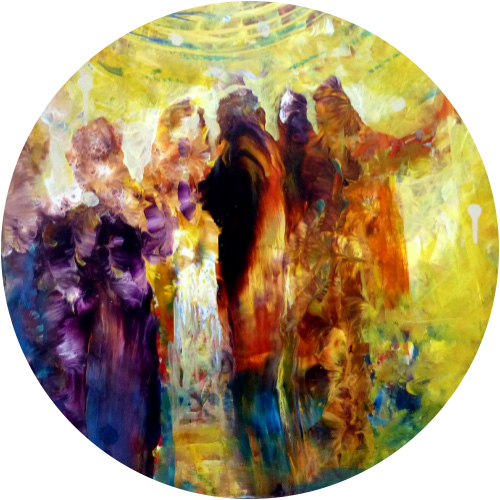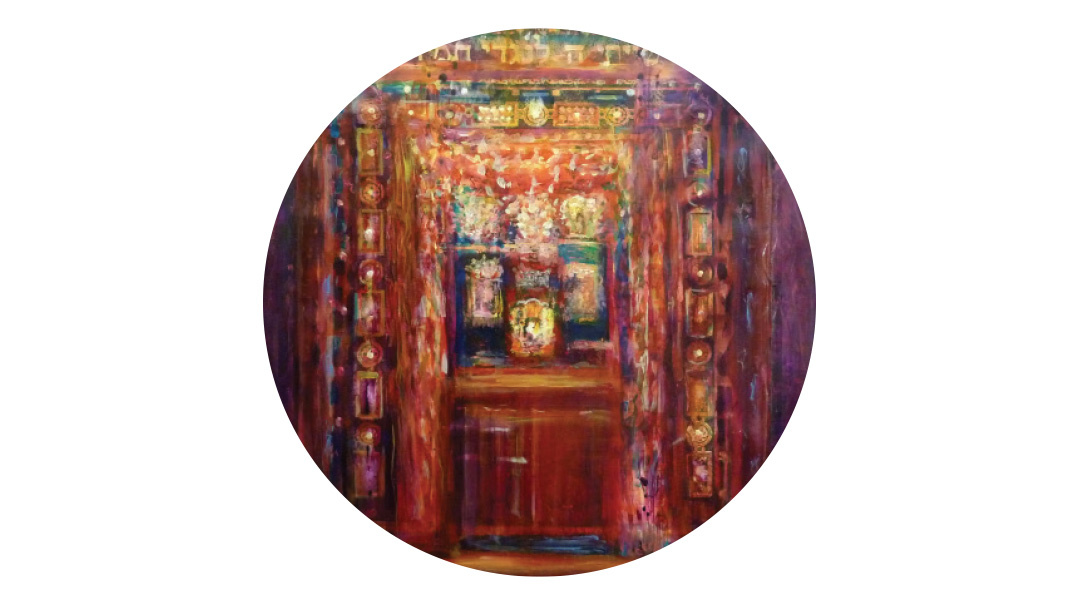Mask Mandates

When we hide from reality, He hides from us

H
ow do we arrive at Purim this year? How do we emerge from the upheavals and catastrophes that have befallen us since Adar two years ago, to embrace this day with the unbridled joy that it demands?
This question is neither theatrical nor theoretical, for Chazal appear to call for reckless abandon on Purim: “He must drink wine to the point of ad d’lo yada, until he no longer knows the difference between arur Haman, accursed Haman, and baruch Mordechai, blessed Mordechai.”
A person’s daas, his ability to perceive and discern, is his finest asset. Why would we relinquish this? What would it accomplish? And what meaning does this directive have for people who don’t drink, such as women?
The Root of Sin
The story of Purim begins, as do all dangers that befall our people, with temptation and sin. Yet the sin is rooted far earlier in history than the acts of reveling in Achashveirosh’s party and bowing down to Nevuchadnetzar’s idol. It begins with the very first confrontation between man and evil: the sin of eating from the Eitz Hadaas, the Tree of Knowledge.
Our Sages, who knew that all the history of the world is alluded to in the Torah, asked, Haman min haTorah minayin? Where is Haman’s name found in the Torah? And they discover it in the words of Hashem — half-question, half-indictment — to the first sinners, Adam and Chavah: Hamin ha’eitz — have you eaten from the tree that I forbade you to eat?
The connection between Haman and the tree is more than a play on the words “Haman” and “Ha-min.” Haman was but one manifestation of the forces of evil, which were created by Hashem to challenge man. They were first embodied in the serpent who convinced Chavah to disobey her Creator and eat the fruits of the forbidden tree.
Prior to their sin, Adam and Chavah had a clear, objective vision of right and wrong. They instinctively identified with Hashem’s Will, and disobedience was only a theoretical possibility. When the serpent opened their eyes to many more options, the ensuing sin had a devastating, lasting effect on the psyche of mankind. Today, we wrestle constantly with choosing between Hashem’s law and our own opinions, emotions, and desires — in short, with what seems “good” or “bad” in our eyes. Hence the name of the tree: Eitz Hadaas Tov V’ra, the Tree of Knowledge of Good and Evil.
Clarity and Ambiguity
Man makes choices using daas, his ability to make informed decisions by distinguishing good from evil and right from wrong. He needs clarity to be able to submit his own will to that of his Creator.
Thus we daven for daas in the first specific brachah of the everyday Shemoneh Esreh: Atah chonen l’adam daas. Similarly, the goal of the Makkos in Mitzrayim was daas — “vidatem ki Ani Hashem — so that you shall know that I am Hashem” (Shemos 10:2).
The Makkos delivered clarity; in contrast, the forces of evil generate ambiguity. The first step to cause someone to sin isn’t to convince him to actually transgress a prohibition, but to mitigate the idea that sin is dreadful and that mitzvos are compelling.
The serpent’s opening line to Chavah, “Even if Hashem said not to eat from the tree…” was cleverly designed to diminish her natural, instinctive horror of rebelling against the Divine Will. “Even if…” is a familiar phrase the yetzer hara uses, until the present day, to diminish our spiritual passion. (“So what?” “Nu, nu,” “What difference does it make?” and “Aren’t we allowed to live a little?” are others.)
In the Purim story, Haman is the serpent. He reawakened the sin of eating from the forbidden tree by convincing Achashveirosh to insist the Jews of Shushan attend his party and partake of its pleasures. (The Megillah closes on a particularly satisfying note: Haman meets his end on a tree.) The scene of the Jews indulging themselves in full view of the plundered Temple vessels calls to mind the irreverent attitude of “so what?”
Another strategy of the serpent was to push Chavah against the tree in order to demonstrate that touching the forbidden article posed no immediate danger. Years later, the Amalekites, the embodiment of evil among the nations, tried to create the same effect when they waged war on the nascent Jewish nation to dispel their aura of invincibility after the splitting of the Yam Suf. Message to the world: Perhaps Hashem’s children aren’t untouchable after all.
Thus the goal of Amalek, in its various manifestations throughout the generations, is to cast doubt and generate confusion. This is underscored by the fact that its gematria (the numerical equivalent of the Hebrew letters that spell its name) is equivalent to that of the Hebrew word for doubt — safeik. Amalek attempts to mask the truth by creating illusions.
Amalek’s power is generated by our actions. It was only after the nation complained about the lack of water in the desert, saying, “Is Hashem in our midst or not?” that Amalek came to harass them. When we doubt Hashem’s Presence and involvement in our lives, we empower Amalek. In other words, when we hide from reality, Hashem hides from us. He dons a mask and gives us the impression we can no longer count on His constant Presence.
The reverse is true as well. How do we “wipe out the memory of Amalek from beneath the heavens” (Devarim 25:19)? When we reveal the reality of Hashem’s Presence to the world — when we unmask Him through our actions and our history — we destroy Amalek.
Revealed and Hidden
Thus Klal Yisrael’s journey throughout history is one of concealment and revelation, illusion and truth, disguising and unmasking.
The first example of this pattern is the immediate aftermath of the first sin. Adam and Chavah instinctively conceal themselves, as if they can hide from Hashem. Hashem plays along with them.
“Ayekah? Where are you?” He asks. “Could you possibly have eaten from the forbidden tree?”
The theme of concealment runs throughout the Purim story. The term “Megillas Esther” can be translated as “the revelation of the hidden” (Esther’s name is derived from hester, concealment). Hashem’s Name doesn’t appear in the Megillah at all, and the story seems to unfold naturally.
The Purim salvation was unique in that it featured no stunning changes of nature. It happened during the Persian exile, and we remained in galus at the end of the story. Because the events occurred over a period of nine years, they could have easily been written off as coincidence. Klal Yisrael chose, instead, to use their daas to perceive Hashem’s Face behind the mask in every detail.
For example, when the Jews of Shushan attended Achashveirosh’s feast, Hashem immediately said to the satan, “Bring me a scroll and I will write upon it annihilation (Midrash Esther Rabbah).”
Yet before Haman was permitted to instigate his terrible decree, Hashem pulled other strings. At the very same party, He arranged for the ousting of Vashti, to make room for Esther to enter the palace. In the words of our Sages, Hashem prepares the refuah lifnei hamakkah, the remedy before the rebuke. The deeper meaning of this pattern is that since the ultimate purpose of Hashem’s rebuke is its remedy, the latter is conceptualized first.
The term, hester Panim, the hiding of Hashem’s Face, suggests that the Face is there, but that it’s masked. As Rabbi Akiva Tatz puts it, when one wants to escape detection, he only has to wear a mask if he’s nearby. If he’s very far, we don’t see him anyway. Furthermore, Hashem’s concealment is a double illusion, for its very purpose is to induce us to look for Him. The goal of the rebuke is its remedy.
In today’s parlance: There may sometimes be masking, but there is never distancing.
We — both drinkers and non-drinkers! — are now in a position to understand that the startling command of ad d’lo yada foreshadows the depth and the joy of the end of days, when we’ll merit the ultimate revelation of Hashem’s constant Presence.
When a person is drunk, he is lo yada, he has no daas. Any decisions he makes are random, not logical. (In fact, the name “Purim,” “lots,” recalls the lottery that Haman employed to find the right date for his scheme. One who makes a decision based on throwing lots is consciously setting aside his daas.) We look forward to the time when we’ll naturally choose good over evil, baruch Mordechai over arur Haman — d’lo yada — just as Adam did before his sin.
When a person is drunk, he’s unproductive and unaware. On Purim, we take ourselves out of the picture. We have no say, no agenda, no control. There is nothing but HaKadosh Baruch Hu — His Will, His love, His Presence. And when we relinquish ourselves entirely to Him, we can experience the intense joy of knowing that He alone is in charge, and that He can bring salvation even as we languish in galus.
On a deeper level, in surrendering to Hashem’s agenda, we express the understanding that there is no difference after all — ad d’lo yada! — between arur Haman and baruch Mordechai. All events and all forces, both good and evil, were created by Hashem and all exist for our own good. Haman’s decree ultimately saved the Jews of Persia from oblivion, for it led to mass teshuvah and tefillah and a reacceptance of kabbalas haTorah.
Rav Shimshon Pincus ztz”l reminds us that when a person is drunk, he’s stripped of all pretenses, disguises, and social conventions; his essence is unmasked. On Purim, we’re in touch with the deepest part of ourselves, and we discover that at the very core of our identity lies the purest potential.
The Gemara (Megillah 12a) asks about the Purim story, “If Yisrael sinned, why were they saved? Does Hashem show favoritism?” Listen carefully to the answer, so that we can arrive to Purim this year with the firm knowledge that we’ll never be abandoned. The Gemara responds that Yisrael only sinned out of fear of Achashveirosh, but that their inner selves remained whole.
The beauty of Purim’s masks, Rabbi Moshe Eisemann offers, is that they can so easily be removed. And then the pure inner self is revealed.
Sources include the writings of Rav Gedaliah Schorr, Rav Shimshon Pincus, Rav Yaakov Moshe Kulefsky, Rav Aaron Rubinfeld, and Rav Pinchas Friedman.
Mrs. Shani Mendlowitz is menaheles of Bais Yaakov Seminary of Montreal, and a popular lecturer for women.
(Originally featured in Family First, Issue 784)
Oops! We could not locate your form.






